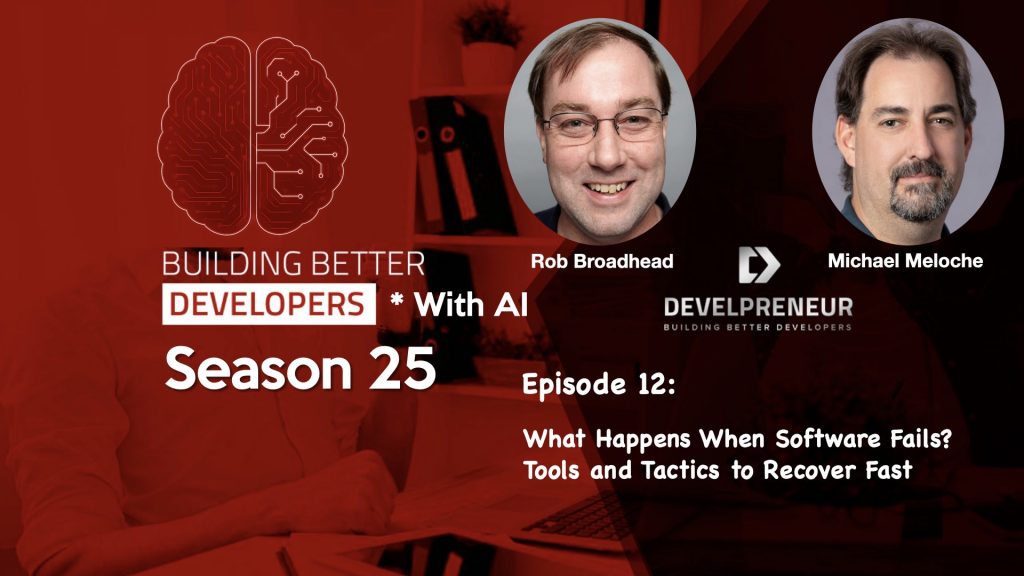In this episode of Building Better Developers with AI, Rob Broadhead and Michael Meloche revisit a popular question: What Happens When Software Fails? Originally titled When Coffee Hits the Fan: Developer Disaster Recovery, this AI-enhanced breakdown explores real-world developer mistakes, recovery strategies, and the tools that help turn chaos into control.
Whether you’re managing your first deployment or juggling enterprise infrastructure, you’ll leave this episode better equipped for the moment when software fails.
When Software Fails and Everything Goes Down
The podcast kicks off with a dramatic (but realistic) scenario: CI passes, coffee is in hand, and then production crashes. While that might sound extreme, it’s a situation many developers recognize.
Rob and Michael cover some familiar culprits:
- Dropping a production database
- Misconfigured cloud infrastructure costing hundreds overnight
- Accidentally publishing secret keys
- Over-provisioned “default” environments meant for enterprise use
Takeaway: Software will fail. Being prepared is the difference between a disaster and a quick fix.
Why Software Fails: Avoiding Costly Dev Mistakes
Michael shares an all-too-common situation: connecting to the wrong environment and running production-breaking SQL. The issue wasn’t the code—it was the context.
Here are some best practices to avoid accidental failure:
- Color-code terminal environments (green for dev, red for prod)
- Disable auto-commit in production databases
- Always preview changes with a SELECT before running DELETE or UPDATE
- Back up databases or individual tables before making changes
These simple habits can save hours—or days—of cleanup.
How to Recover When Software Fails
Rob and Michael outline a reliable recovery framework that works in any team or tech stack:
- Monitoring and alerts: Tools like Datadog, Prometheus, and Sentry help detect issues early
- Rollback plans: Scripts, snapshots, and container rebuilds should be ready to go
- Runbooks: Documented recovery steps prevent chaos during outages
- Postmortems: Blameless reviews help teams learn and improve
- Clear communication: Everyone on the team should know who’s doing what during a crisis
Pro Tip: Practice disaster scenarios ahead of time. Simulations help ensure you’re truly ready.
Essential Tools for Recovery
Tools can make or break your ability to respond quickly when software fails. Rob and Michael recommend:
- Docker & Docker Compose for replicable environments
- Terraform & Ansible for consistent infrastructure
- GitHub Actions, GitLab CI, Jenkins for automated testing and deployment
- Chaos Engineering tools like Gremlin and Chaos Monkey
- Snapshot and backup automation to enable fast data restoration
Michael emphasizes: containers are the fastest way to spin up clean environments, test recovery steps, and isolate issues safely.
Mindset Matters: Staying Calm When Software Fails
Technical preparation is critical—but so is mindset. Rob notes that no one makes smart decisions in panic mode. Having a calm, repeatable process in place reduces pressure when systems go down.
Cultural and team-based practices:
- Use blameless postmortems to normalize failure
- Avoid root access in production whenever possible
- Share mistakes in standups so others can learn
- Make local environments mirror production using containers
Reminder: Recovery is a skill—one you should build just like any feature.
Think you’re ready for a failure scenario? Prove it.
This week, simulate a software failure in your development environment:
- Turn off a service your app depends on
- Delete (then restore) a local database from backup
- Use Docker to rebuild your environment from scratch
- Trigger a mock alert in your monitoring tool
Then answer these questions:
- How fast can you recover?
- What broke that you didn’t expect?
- What would you do differently in production?
Recovery isn’t just theory—it’s a skill you build through practice. Start now, while the stakes are low.
Final Thought
Software fails. That’s a reality of modern development. But with the right tools, smart workflows, and a calm, prepared team, you can recover quickly—and even improve your system in the process.
Learn from failure. Build with resilience. And next time something breaks, you’ll know exactly what to do.
Stay Connected: Join the Developreneur Community
We invite you to join our community and share your coding journey with us. Whether you’re a seasoned developer or just starting, there’s always room to learn and grow together. Contact us at [email protected] with your questions, feedback, or suggestions for future episodes. Together, let’s continue exploring the exciting world of software development.

